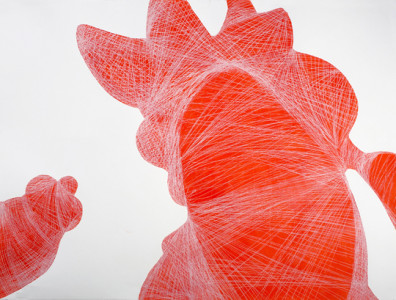‘Vermilion/Vermillion’ open to interpretation

The energetic shapes in the abstract exhibit at Vermillion Art Gallery and Bar are untethered to reality.
The voluptuous pink paintings of Ellen Ziegler, now on view at Vermillion on Capitol Hill, depict roly-poly floating objects that are unmoored from everyday reality. Like other artists who practice dimensional abstraction, Ziegler skillfully uses the tools of realism, like shading and perspective, to make her creations look solid and convincing, but they aren’t depictions of anything in particular. What they lack in familiarity, however, they make up with their highly kinetic visual energy.
Ziegler’s creatures billow like clouds, writhe like eels, sprout appendages and spray out excretions; they suggest, among other things, various life forms, both large and microscopic. Everything is painted in the same shade of red, and part of the show is devoted to an illustrated discussion of the type of red in question — vermilion — and its long and rich history. Ziegler also posts a short homage to Vermillion the venue, the bar/gallery that is hosting the current show and ended up with this exhibit partly because of the coincidence of names.
We can’t look to Ziegler’s titles for insights as to what these pictures might be about, with names like “Vermilion Series III, #1-9 (2016).” “Series III,” in fact, is a grid of nine small paper rectangles, each with its own red and bulbous inhabitant. It’s a true rogue’s gallery in terms of variety, even though everything is the same color and scale.
One particularly striking panel in the center of the group depicts a heartlike entity that seems to have sprung several leaks. Its vivid dimensionality is achieved through a very simple but effective technique. Ziegler applies a mesh of extremely delicate and carefully contoured white lines onto the original flat, red blob, getting denser and brighter at the edges and fading in the middle, thus creating the illusion of a very complex sculpted form lit from behind. Tiny, energetic clouds of thinned-down paint escape from the margins of this biological-looking shape, giving it a feeling of being in motion, perhaps slowly disintegrating before our eyes.
Other sheets in the grid contain blobs that remind one of balloons in the Macy’s Thanksgiving Day Parade (the white lines could be the network of restraining ropes); stalks of ginger; or external metal appendages on a satellite or space capsule. Some of the forms appear to be birthing new extensions as they gracefully swim through space. Others seem to struggle against their containing web of white lines, as if straining to break free.
The shapes in “Vermilion Series II,” a set of three larger works on the opposite wall, have much stronger figurative suggestions. A grinning rabbit appears to be about to eat a pointy, succulent plant, and two broad-hipped feminine torsos twist in a sort of dance with smaller creatures to their right and left. Or not. The images are sort of three-dimensional Rorschach blots, with interpretations particular to each viewer.
It’s hard not to think about the current economics of the art world when considering strong and sophisticated shows like this one, by a veteran artist. “Alternative” spaces like Vermillion are becoming increasingly important as the roster of commercial galleries shrink, but the prices of some of the works in the exhibition, particularly the smaller ones, seem untethered to their value, being the equivalent of a meal for two at a good restaurant. In a buyer’s market with a diminishing marketplace, what’s the artist to do?
Artist, author and critic Gary Faigin is co-founder and artistic director of the Gage Academy of Art.
Category: Press





